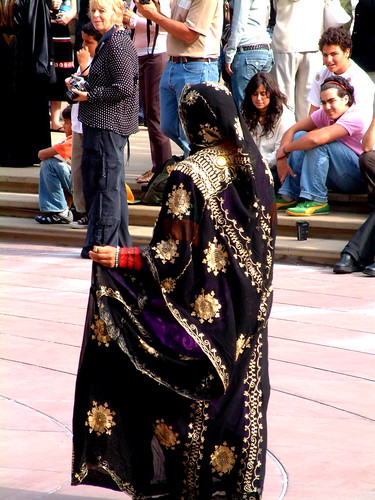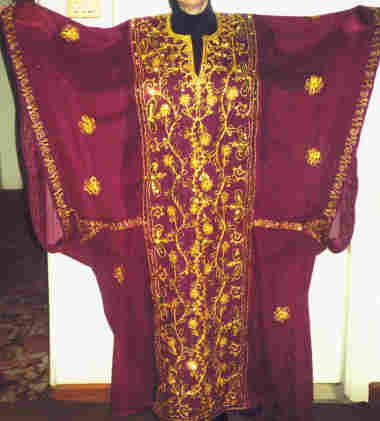








 This is really weird and :
This is really weird and :








 This is really weird and :
This is really weird and :











"Almost all Anatolian (Turkish) jewelry has a special meaning of its own and its own story, and the 'Hand of Fatima Necklace' is one of these, a lovely piece of silver and gold from which silver hands are hung and in whose good luck the women of Anatolia (Turkey) believe. Its romantic story is as follows: One day Lady Fatima (daughter of the Holy Prophet Mohammed) was roasting halvah (a sesame honey cookie) in a pan in the garden when suddenly the door opened and her husband the prophet Ali entered along with a new and beautiful female slave. When the Lady Fatima saw her husband's beautiful young concubine (slave-girl), she was deeply grieved and in confusion began stirring the halvah with her hand. Because of the grief in her heart she never even felt the pain of her hand mixing the hot halvah. However, when her husband hurried to her side and exclaimed in surprise "What are you doing there, Fatima?" she felt her hand burning and the pain. Thus it is from that day on the hand of the Lady Fatima has been used in the Islamic world as a symbol of patience, abundance, and faithfulness, and thus it is that girls and women wearing this necklace from whose end the hands hang believe the hands of Lady Fatima will bring them good luck, abundance and patience."
"The motif (pattern) of the Hand of Fatima is used everywhere in North Africa, especially in jewelry and in door knockers, naturally, because it keeps away the Evil Eye, considered to be a problem there."
"Fatima was the daughter of the prophet Mohammed, but in fact this hand has been around before Islam, and there is still much right hand-left hand magic in Morocco. The left hand is for doing bad things; it also protects against the evil eye if you put it palm up in front of you (so naturally that's an insulting thing to do to someone, implying they have the evil eye)."





















Central Region of Saudi
The central region of Saudi Arabia is called the Najd or highland. Riyadh meaning "the gardens" lies in the center of Najd and was once part of a vast oasis of date palm trees and other vegetation. Historians believe that this oasis was settled in the sixth century B.C. which accounts for the fact that the town's people of the Najd have always outnumbered the nomadic people. Riyadh is now the capital of the Kingdom, but the most important Historical site in the Najd is Diraiyah.
Restoration of this town is still going on and will soon be available for view.



Najdis have a reputation for being pious and conservative. They inherited strong ideals, and great traditions of hospitality and generousity were fostered. Occasions for celebration were eagerly sought in olden times, by the people of the Najd. Music and singing, sword dances and desert banquets brightened. The hard life of the desert. The people here particularly enjoy eloquence in both conversation and poetry and this accounts for the fact that much of the finest Arab verse was composed in this region. Poems depict the life and ideals of traditional society, which involve honor, manliness and fortitude.

The Northen Region of Saudi
The Northern region includes some of the earliest cities of Arabia, such as Jouf and the towns of Wadi as Sirhan. One of the larger Arabian Tribes, the Rwalla, travel across a "Dirah" or traditional tribal ground spanning a vast area which cross the Saudi Arabian northern border.


There is little available evidence to date developed crafts in the Northern region, but there is enough to suggest that garments were tailored by the Bedouin in the Mid-Ninteenth century. The Rwalla and Shammar tribes went to Hail for the textiles and clothes. The traditional costume of the Rwalla bedouin women which has been described as a large dark headscarf folded into a triangle. Wealthy women wore a headscarf called "Shumbar". On the top was worn headband called "Sibta".
West Region of Saudi
The Hijaz, or Western Arabia, is home to the oldest cosmopolitan centers of the Kingdom, the port of Jeddah, Taif, and the Holy Cities of Mekkah and Medina. The name Hijaz means "barrier" and refers to the great rock escarpment that, with the Red Sea, forms a natural corridor. Since the time of the Prophet, Muslims from all over the world have made their Pilgrimage to Mekkah, bringing with them their crafts and costumes which remained as an influence. It is not surprising that incredibly beautiful traditional costumes are found there, particulary in Mekkah where the women's garments are unique.


The traditional costumes worn by the town's women of the Hijaz concentrates a great deal of attention on the emblishment of the "Sidaireeya" (under blouse) and "Sirwal" (long pants) as these are designed to be worn only with the sheer Thawb, also known as Kurtah. The traditional headgear of Hijaz women is known as "Mihramah and Mudawwarah". It is composed of three pieces : the triangular "Shambar", the rectangular "Mihramah" and the square "Mudawwarah". On special occasions, elaborate diamond-studded brooches are often set at every top of the "Mihramah and Mudawwarah".


The most elaborate women's masks are from Western Arabia, particulary those worn by the various Harb and Utaybah Tribes. Burkha is made of leather or cotton textiles, both Red and Black, and variously decorated with Red paint, coins, shells, metalwork, beads, tassles and appliqued cloth. Sometimes the masks take as long as six Months to complete. The workmanship is often very skilled as Bedouin girls are taught, how to make masks from childhood. The masks are matched with Black Blue, or Green colored dresses with angular shaped sleeves.
The traditional dresses of women in Al Hada and Shefa are characterized by wide horizontal stripes of alternating Black and Blue color, with a peculiar piece of embroidery on the chest and a headgear that is unique for these areas. Similarly elegant are the costumes worn by women in Malik and Harith. These dresses typically have a grid of horizontal and vertical stripes from waist down to the hem. A piece of embroidery made out of colored beats adorns the chest and matches a similarly constructed elegant mask. A dark colored head corer, gracefully falling to the back, completes the set.
South Region of Saudi
We now move on to the highlands of the South-Western region which is composed of the highland of Asir and the narrow coastal strip of Tehama.
Asir means "difficult region" and refers to South-West Arabia where the terrain comprises high peaks, deep terracted valleys, plateaus over 1,200 Meters high and coastal lowland. Because the Asir was nor easily accessible in the past, it was partially isolated from the rest of the Arabia, giving rise to great individuality of costumes customs.
The most prevalent traditional female garment of the Asir is a straight-sleeved, shaped Kaftan. The traditional dress sometimes has so much embroidery, that at a distance, the base textile appears to be multi-colored rather than black.
Women rarely veil in the South-West but do cover their heads in most areas of the Asir. There are many kinds of Headgear in the region including unusual heavily decorated cotton hoods and several styles of straw hats.
Lot of ornamentations is worn with the colorful costumes of the Asir women. Rijai, a Tehama stone-built village, is famous for its goldsmithing, while Najran, at the Southern tip of the mountain chain, traditionally produced chunky silver Bedouin jewelry. Ornaments of the South-West are often fashioned from a combination of leather and silver.
Eastern Region of Saudi
The Eastern province of Saudi Arabia, sometimes referrd to as Al Hasa, was once famous for its magnificent palm grovers and pearls. The region comprises vast sandy shores and salt flats, the drifting sands of the Dahna Desert, a rock plateau called the Summan, and a section of the great Southern Desert, the Rub al-Khali, also known as the Empty Quarter.
For a woman in the Eastern province (Gulf area) has been a sheer over-dress with enormous sleeve openings. It is the fashion to draw one sleeve up over the head to form an elegant hood. It is known as the "Thawb Nashal". The other woman's traditional garment still popular today as a hooded cloak known as "Bukhnuq".
Traditional headgear for rural women in the Eastern province was the "Umm Raugella" a black rectangle consisting of four segments. This was worn over the hair and hanging down over the neck of the Thawb. Town women added the "Milfa" a straight piece of black cotton cloth drawn over the lower part of the face. Some wome wore a short mask (Burkha) is known as "Batula".